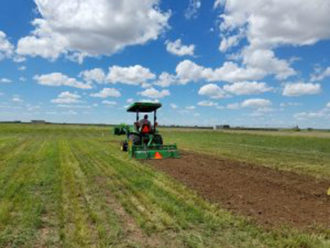LUBBOCK, Texas – In the Texas High Plains, a region where the water-depleting Ogallala Aquifer endangers productive agriculture, and hot, arid winds erode soils and rob them of nutrients, cover crops offer a useful option to livestock producers.
In a two-year graduate student study at Texas Tech University, funded through the Southern Sustainable Agriculture Research & Education (SSARE) program, winter cover crops – specifically rye – helped build healthy soils while preserving precious water for summer crops in minimally tilled forage-based grazing systems.
“The results help quell concerns from farmers that cover crops withdraw soil water to the detriment of the summer grazing crop, and more importantly don’t require any more irrigation than fields left fallow,” said Lisa Baxter, the graduate student who conducted the study, and is currently a post-doctoral research associate in the Department of Crop and Soil Sciences at University of Georgia. “It encourages producers to cover their fallow fields in the winter to cut down on erosion, stabilize the soil structure, and stem the loss of soil nutrients.”
The project (GS15-152), “Evaluation of Winter Annual Cover Crops Under Multiple Residue Managements: Impacts on land management, soil water depletion, and cash crop productivity,” is the latest in over two decades of research from Texas Tech University that is reshaping the agricultural landscape in the Texas High Plains: from monocultures of continuous cotton production to more dryland and ultra-low irrigated cattle grazing systems.
The goal, said plant and soil scientist Chuck West, has been to shift away from systems that heavily rely on irrigation – coming from the Ogallala Aquifer – to profitable production practices that support forage crops which require little to no water and rebuild soil health.
“Cattle production has always been crucial to the region’s agriculture community,” said West, who specializes in forage-systems research. “Forage-livestock systems are a viable option for the future of west Texas agriculture, and the inclusion of cover crops managed as surface residue could preserve the economic viability of High Plains agriculture.”
In the SSARE-funded study, the researchers investigated five cover crop species (rye, wheat, burr medic, hairy vetch, and rape-kale) under minimally tilled and no-till, irrigated and non-irrigated systems as complements to a beef stocker-teff grazing system.
The performance of the cover crops was measured for such factors as irrigation and rainfall needs, overall biomass yields, amount of ground cover, crude protein concentration, soil water content, and impacts on the summer teff crop.
Results showed that while each cover crop has its strengths and weaknesses, rye proved to be the most successful, producing consistent yields, even in a dry year, preserving soil water, and not reducing the soil water availability of the subsequent summer cash crop.
Other research results concluded that:
- Winter cover crops did not require more irrigation than the winter fallow.
- Switching to no-till reduced soil water loss and increased teff yields.
- Use of a winter cover crop did not decrease soil water reserves.
- A cover crop mixture of rye and hairy vetch shows promise as a winter management strategy.
The agriculture industry in the Texas High Plains continually evolves to adapt to new technology and environmental conditions. The imminent disappearance of aquifer resources should encourage producers to seek innovative alternatives to safeguard against dramatic losses of income when pumping capacity is insufficient for irrigated crops.
Published by the Southern Region of the Sustainable Agriculture Research and Education (SARE) program. Funded by the USDA National Institute of Food and Agriculture (NIFA), Southern SARE operates under cooperative agreements with the University of Georgia, Fort Valley State University, and the Kerr Center for Sustainable Agriculture to offer competitive grants to advance sustainable agriculture in America's Southern region. This material is based upon work that is supported by the National Institute of Food and Agriculture, U.S. Department of Agriculture, through Southern Sustainable Agriculture Research and Education, under sub-award number: GS15-152. USDA is an equal opportunity employer and service provider. Any opinions, findings, conclusions, or recommendations expressed in this publication are those of the author(s) and do not necessarily reflect the view of the U.S. Department of Agriculture.
